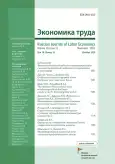Working potential of the unemployed population in regions with high unemployment: characteristics and prospects for using the potential
- Authors: Zabelina O.V.1
-
Affiliations:
- Federal State Budgetary Institution “All-Russian Scientific Research Institute of Labor” of the Ministry of Labour and Social Protection of the Russian Federation
- Issue: Vol 10, No 11 (2023)
- Pages: 1651-1666
- Section: Articles
- URL: https://journals.eco-vector.com/2410-1613/article/view/625107
- DOI: https://doi.org/10.18334/et.10.11.119318
- ID: 625107
Cite item
Abstract
In the conditions of growing labor shortage and reaching the historical minimum of unemployment, the problem of underutilization of the labor potential of the unemployed has persisted for many years in a number of regions of Russia. The Top-10 regions with the highest unemployment rate were identified; and their problem profile was compiled.This profile includes the main indicators of labor market tension. In the context of the gender, age and social groups of the unemployed, their educational level and practical experience, industries, and groups of occupations, the assessment of the labor potential of the unemployed population was carried out. The author draws conclusions about a deep imbalance of supply and demand in the labor markets of problem regions with an unbalanced structure of personnel training and a high proportion of youth unemployment. There is a general decrease in the quality of the labor potential of the unemployed population as a labor reserve and a low readiness of the job-seeking population for labor mobility within and outside the region. The article presents proposals for creating opportunities to use the workforce potential of regions with high unemployment, which may be of interest to federal and regional authorities, as well as researchers and experts studying the problems of the Russian labor market.
About the authors
Olga Viktorovna Zabelina
Federal State Budgetary Institution “All-Russian Scientific Research Institute of Labor” of the Ministry of Labour and Social Protection of the Russian Federation
Email: Zabelina_OV@vcot.info
References
- Путин В.В. Выступление на Пленарном заседании Петербургского международного экономического форума. Kremlin.ru. [Электронный ресурс]. URL: http://kremlin.ru/events/president/news/71445 (дата обращения: 27.09.2023).
- Солнцев С.А., Емелина Н., Лопатина М.В. Особенности безработицы на российском рынке труда. / Информационный бюллетень. - М.: Изд. дом Высшей школы экономики, 2021. – 51 c.
- Региональные рынки труда в новых экономических условиях. Фонд laquo;Центр стратегических разработокraquo;. [Электронный ресурс]. URL: https://www.csr.ru/upload/iblock/346/427t0sggji8w6cuuw7263hy1mna08jlm.pdf (дата обращения: 27.09.2023).
- Коровкин А.Г., Долгова И.Н., Королев И.Б., Синица А.Л. Оценка напряженности на рынке труда: региональный и отраслевой аспекты // Научные труды: Институт народнохозяйственного прогнозирования РАН. – 2020. – № 18. – c. 449-465. – doi: 10.47711/2076-318-2020-449-465.
- Забелина О.В., Мирзабалаева Ф.И., Санкова Л.В. Региональная трансформация напряженности на рынке труда: новые векторы // Лидерство и менеджмент. – 2022. – № 1. – c. 137-160. – doi: 10.18334/lim.9.1.114287.
- Забелина О.В., Мирзабалаева Ф.И. Новые тренды занятости в неформальном секторе как вызовы политике формализации российского рынка труда // Экономика труда. – 2023. – № 2. – c. 263-278. – doi: 10.18334/et.10.2.117222.
- Архипова Л.С., Горохова И.В. Влияние миграционных процессов на экономическую безопасность и пространственное развитие России // Вестник Российского экономического университета имени Г.В. Плеханова. – 2022. – № 3(123). – c. 119-133. – doi: 10.21686/2413-2829-2022-3-119-133.
- Ерохина Е.В., Гретченко А.И. Проблемы развития промышленного и кадрового потенциала Северо-Кавказского федерального округа // Вестник НГУЭУ. – 2021. – № 2. – c. 140-152. – doi: 10.34020/2073-6495-2021-2-140-152.
- Монгуш С.П., Кылгыдай А.Ч. Индивидуальные программы социально-экономического развития проблемных регионов Российской Федерации // Азиатско-тихоокеанский регион: Экономика, политика, право. – 2022. – № 3. – c. 45-72. – doi: 10.24866/1813-3274/2022-3/45-72.
- Санкова Л.В., Мирзабалаева Ф.И. Региональная асимметрия рынков труда и вызовы политике занятости // Проблемы развития территории. – 2018. – № 4(96). – c. 104-123. – doi: 10.15838/ptd.2018.4.96.7.
- Баскакова М.Е. Потенциальная рабочая сила современной России: социально-демографический портрет и уровень образования // Социально-трудовые исследования. – 2022. – № 3(48). – c. 105-117. – doi: 10.34022/2658-3712-2022-48-3-105-117.
- Антонова Г.В., Мирзабалаева Ф.И., Бондарчук А.Г. Трансформация портрета безработного на регистрируемом рынке труда под влиянием институциональных и экономических факторов // Экономика труда. – 2020. – № 8. – c. 693-712. – doi: 10.18334/et.7.8.110781.
- Итоги выборочного обследования рабочей силы. II квартал 2023 года. Федеральная служба государственной статистики. [Электронный ресурс]. URL: 27.09.2023.
Supplementary files









